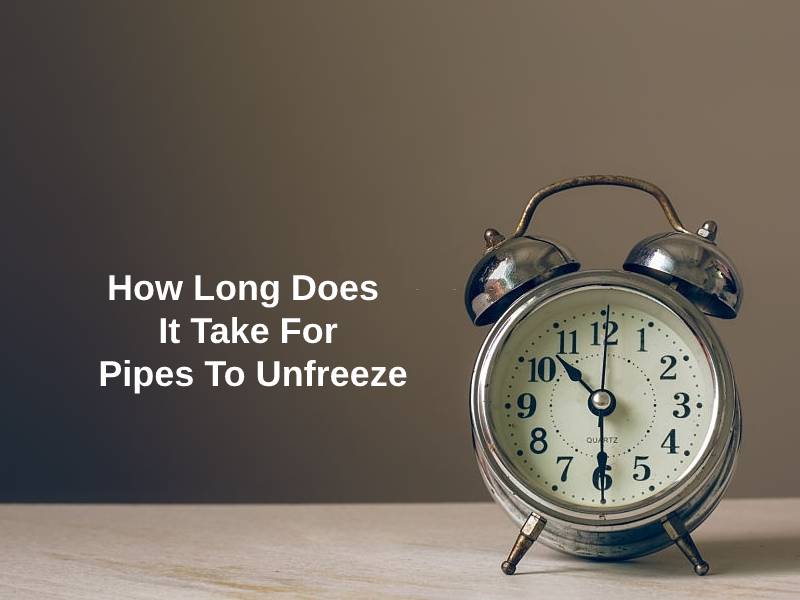Exact Answer: Up to 6 Hours
CPVC and PVC pipes are among the most commonly used pipes in houses or commercial areas. These are replacing the metal pipes as they are cheaper and prevent more noise than metal pipes. Although, due to high pressure or some other malfunction, pipes may start to freeze. Lack of heat inside or around the house can also cause Pipe Freezing. Freezing of pipes is not just merely a collection of frost in pipes, but rather they may lead to Pipe bursting. Pipe Freezing and Pipe Bursting can also harm the house. So, one may wonder how long a house can go without enough heat before pipes freeze.

How Long Can A House Go Without Heat Before Pipes Freeze?
Overall, it depends on what is the temperature around the pipes and the house. Also, it depends on the temperature of the water as well. For an instance, let’s assume the temperature of the water in pipes is 20 degrees Celcius. The process of Freezing of pipes would be as follows: First, the temperature of water starts to go down which is initial cooling. At this stage, no ice is formed. This stage lasts for merely 1-2 hours. Then, after some time, water reaches its freezing point i.e., 0 degrees Celcius. Now, the process of dendritic ice formation starts. The water slowly turns into ice and stays at 0 degrees Celcius for a period of time. Finally, the annular ice starts to form in the pipe as the temperature of the water goes below 0 degrees Celcius. This stage comes after around 2-4 hours of water reaching its freezing point. After this stage, there is a high risk of pipe bursting.
The pipe bursting is one of the reasons that pipes are not placed in open areas. As in open areas, the temperature fluctuates more and may cause a heavy fall in the temperature of water much easier to the freezing point. Rather, pipes are well insulated under walls or underground to avoid freezing as well as bursting. The uninsulated pipes can only last up to 3 hours as their temperature falls much faster. That is why it is recommended that pipes should be kept under insulation which prevents pipe freezing and bursting.
| Insulation | Time |
| Proper Insulation | Up to 6 hours |
| No/Poor Insulation | Up to 3 hours |
Why Does It Take That Long For A House To Go Without Heat Before Pipes Freeze?
The Pipes start to freeze because of lack of heat. The initial cooling of water pipes is rather fast. It takes a lot less time for water to reach near 0 degrees Celcius from 20 degrees Celcius. In this stage, the temperature of the water goes down and the water becomes cold, but not cold enough to become frozen. No water is stopped in the pipe but the pipe is rather cold so the flowing water also becomes colder. The second stage is long. In this stage, water starts turning into ice. The process is long as the flowing water keeps breaking the newly made ice and the temperature makes the water freeze.
Eventually, the temperature of the freezing water starts to fall further after a few hours. This leads to complete blockage of pipe and hence pipe bursting. The Pipe Bursting happens when the water keeps flowing but it has no way to move forward. Also, the ice is much denser than the water. When the water is turned into ice it requires more space and eventually, it leads to pipe bursting.
However, it is highly recommended that one always should keep their house pipes in proper insulation. If the pipes are placed outside the walls openly without any insulation, the risk of pipe freezing is comparatively much more. Although if one has to confront pipe-freezing when there is a lack of heat in the house and around the pipe., they should contact the plumber as early as possible.
Conclusion
The freezing of pipes is a big problem. Due to heavy flow, bad or no insulation, or some other malfunction, the temperature of water pipes may start to fall. As the temperature of the water goes down, it reaches a point where it starts to freeze. At this stage, the temperature is more stable as the temperature stays 0 degrees Celsius for hours. After a few hours, the water becomes completely frozen and cause pipe blockage or pipe bursting as well. That is why it is recommended to keep pipes in proper insulation. Also, one must immediately contact the plumber if they see any signs of pipe freezing.





















This article is a valuable resource for understanding the stages of water freezing in pipes and how it can lead to bursting. Very informative and insightful.
Agreed, the details provided here are enlightening and useful.
I learned a lot from this article. It’s crucial knowledge for homeowners.
The explanation of the process of water freezing in pipes is thorough and illuminating. Important information for all homeowners.
I appreciate the attention to detail and clarity in explaining this issue. Well done.
Absolutely, this article is a must-read for anyone concerned about pipe freezing.
The scientific explanation of why pipes freeze and burst is valuable knowledge. This article does an excellent job of clarifying this issue.
I found the breakdown of the stages of water freezing to be enlightening. A well-researched article.
The recommendations regarding prompt action and contacting a plumber if pipe freezing is encountered are crucial. This is a very informative article.
Absolutely, the advice provided here is practical and necessary for homeowners.
The article presents the science behind pipe freezing and bursting in a clear and understandable manner. Very well done.
The importance of insulation and the risks associated with pipe freezing are explained thoroughly in this article. Valuable information for homeowners.
Agreed, this article serves as an important resource for homeowners to protect their pipes.
I appreciate the detail and clarity of information in this article. Well-written and informative.
The information about insulation and the impact it has on preventing pipe freezing is critical for homeowners to know. A great read!
Absolutely, it’s important to emphasize the role of insulation in protecting pipes from freezing.
The article provides a well-researched and detailed explanation of how long a house can go without heat before pipes freeze. It’s a great resource for understanding this issue.
I agree, the information provided here is very informative and useful.
This article feels like a timely reminder for homeowners to pay attention to proper insulation and protecting against pipe freezing. It’s a well-written and informative piece.
Definitely a helpful read, especially for those living in colder climates.
Absolutely, it’s important to raise awareness about these potential risks.
This article highlights the critical role of proper insulation in preventing pipe freezing. It’s a significant piece of information for homeowners.
Absolutely, the emphasis on insulation and its impact is conveyed effectively here.
This article serves as an important guide for homeowners, especially those in colder climates.